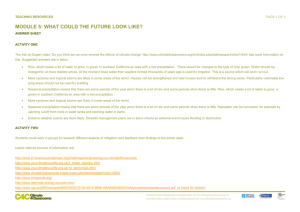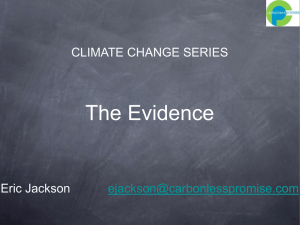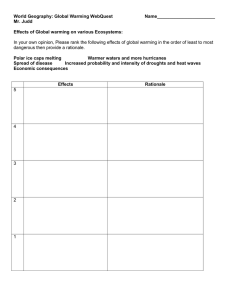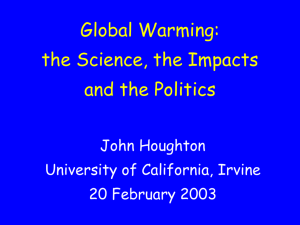1-Clearing the Air PPT application/vnd.openxmlformats
advertisement
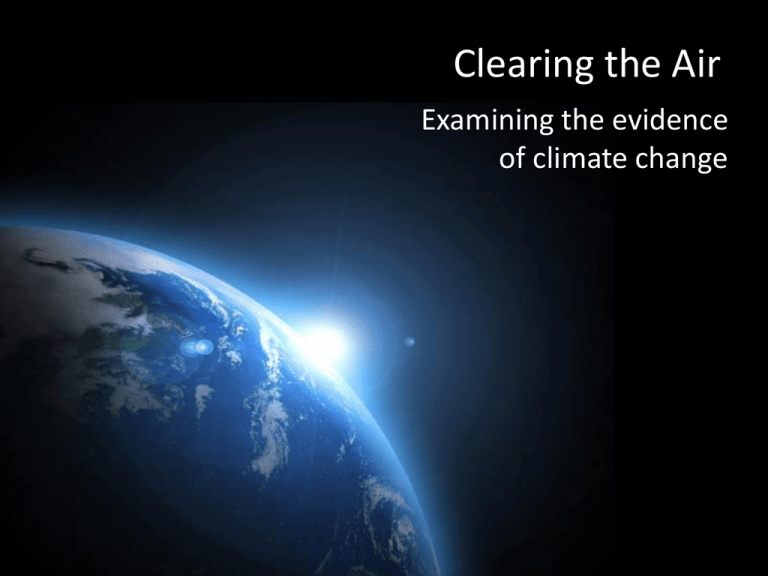
Clearing the Air Examining the evidence of climate change You may have heard statements like… • “Most climate scientists agree.” • “Most scientists don’t agree.” • “Since we can’t predict the weather next week, we can’t know it will be warmer in 100 years.” • “Carbon is natural – what’s the problem?” • “Sea level has already risen and will continue in this century.” Beliefs and Science • People believe many things to be true – Beliefs are ideas for which we think are true – They may be based on evidence, faith, or worldviews • Assumptions are underlying ideas, principles – Used to connect evidence to conclusions – May or may not be reasonable • Science is a process of understanding the natural world – Helps us understand what is happening with evidence – Assumptions are stated, tested, and reviewed Language of Science • Data: Observations and measurements, collected through standard methods • Evidence: Interpreted data that supports or challenges a scientific idea. • Theory: Well-established explanation for how or why a phenomenon happens – Strongly supported by many different lines of evidence • Uncertainty: The range of values within which the true value is likely to fall. – All measurements have some degree of uncertainty – Doesn’t mean “unsure” Weather • What we see or feel outside right now • Daily changes of temperature, rainfall, humidity, wind, and clouds. • Ranges from a few days to a few weeks • Example: today is sunny; the high temperature yesterday was 78F Weather Forecasting • Weather models take into account: – Atmospheric processes – Land surface – Nearby oceans • Weather forecasting accuracy decreases over a few days • Tomorrow’s high temperature is weather forecasting Climate • The long term averages and trends of weather patterns over a given period of time at a given location. • Climate changes cannot be seen annually. • Ranges from a few years, to centuries • Example: Normal monthly precipitation (30 yr average over 1971-2000) in April in Orlando is 2.7 inches Climate Forecasting • Need to account for slow changing conditions: – Amount of snow – Type of land cover • Global climate models take into account: – – – – – Atmospheric conditions and particulates Land surface Ocean and sea ice Vegetation Carbon cycling • Seasonal precipitation for 2013 or future climate in 2100 are examples of climate forecasting Global Warming • An average temperature increase of the Earth over time. Hansen, James, Makiko Sato, Reto Ruedy, Ken Lo, David W. Lea, and Martin Medina-Elizade. "Global Temperature Change." Proceedings of the National Academy of Sciences 103.39 (2006): 14288-4293. Goddard Institute for Space Studies. National Aeronautics and Space Administration, 31 July 2006. Web. 2 July 2012. Climate Change • Includes a variety of likely changes – The effects will not be the same everywhere • Includes changes to: – Temperature – Precipitation – Sea Ice – Sea Level – Extreme Weather Events WHAT IS THE EVIDENCE OF CHANGE? Temperature Courtesy: The Weather Channel Average Temperature 1961-1990 McKenny, Dan, Megan Embrey, Amy Lee, Anantha Aiyyer, Bridget Lassiter, Ryan Boyles, Ashley Frazier, Sharon Schulze, and Heather Dinon. "Climate and Weather." Climate Education for Agriculture. NC State University, Web. 13 July 2012. <http://nc-climate.ncsu.edu/edu/ag/ClimateandWeather>. Temperature IPCC, 2007: Summary for Policymakers. In: Climate Change 2007: The Physical Science Basis. Contribution of Working Group I to the Fourth Assessment Report of the Intergovernmental Panel on Climate Change [Solomon, S., D. Qin, M. Manning, Z. Chen, M. Marquis, K.B. Averyt, M.Tignor and H.L. Miller (eds.)]. Cambridge University Press, Cambridge, United Kingdom and New York, NY, USA. Precipitation Arctic Sea Ice 1979 2009 Sea Ice Armstrong, Richard L. "Sea Ice." State of the Cryosphere. National Snow and Ice Data Center, 21 May 2012. Web. 13 July 2012. <http://nsidc.org/cryosphere/sotc/sea_ice.html>. Sea Level Hansen, James, and Makiko Sato. "Sea Level." Updating the Climate Science: What Path Is the Real World Following? Columbia University, 26 June 2012. Web. 13 July 2012. <http://www.columbia.edu/~mhs119/SeaLevel/>. Ecosystem Bergengren, Jon C., Duane E. Waliser, and Yuk L. Yung. "Ecological Sensitivity: A Biospheric View of Climate Change." Climate Change 107.3 (2011): 433-57. SpringerLink. Web. 22 June 2012. What does this all mean? • Scientists combine this evidence to draw conclusions: – Earth’s climate is currently changing. – Changes are not the same at all locations on Earth. – Future changes may be more rapid than historical changes. • They look at evidence – If these trends do not match historical averages or if they appear to be accelerated, then climate is changing differently than it has in the past. WHY IS CLIMATE CHANGING? Natural and Anthropogenic Changes Climate is defined by several forces • • • • • • Solar radiation Ocean composition Greenhouse effect Albedo effect Continental land arrangement There have been natural fluctuations in these forces that have caused past climate change – Are they causing current changes? The next three slides are to come. • There are some people who believe that the climate change we are seeing today is due to other natural forces, and not anthropogenic – Changes in volcanic activity – Changes in solar radiation – Increased solar flares and sun spots – Changes in Earth’s orbit around the sun Solar Radiation "Glacial-Interglacial Cycles." NOAA Paleoclimatology Program. USA.gov, 20 Aug. 2008. Web. 31 July 2012. Volcanic Eruptions "Frequently Asked Questions about the Science of Climate Change – 2008 Update." Environment Canada. N.p., 18 June 2012. Web. 31 July 2012. <http://www.ec.gc.ca/scitech/default.asp?lang=En>. Global and continental temperature change But natural forces alone do not explain the changes we have been seeing We have also altered the atmosphere • Carbon dioxide (CO2) – Currently 396 ppm; 35% rise since Industrial Revolution • Methane (CH4) – Currently 1800 ppb; from 700 ppb • • • • Nitrous oxide (N2O) Chlorofluorocarbons (CFC’s) Ozone (O3) Water Vapor (H2O) CO2 CH4 N2O Human Forces Humans have amplified the greenhouse effect by putting more greenhouse gases in the atmosphere at an accelerated rate Focus on CO2 • People tend to focus on CO2 because it is the one we have changed the most. • CO2 is a greenhouse gas that scientists think has caused a lot of the warming to take place Carbon is Everywhere! USING MODELS TO PROJECT THE FUTURE What Will Happen In the Future? • Scientists also use models to project temperature changes with different assumptions for emissions "Temperature Projections." Consortium for Atlantic Regional Assessment. Global Change Research Program, US EPA, 23 Jan. 2006. Web. 13 July 2012. <http://www.cara.psu.edu/climate/emissionscenarios3.asp>. What Will Happen In the Future? • Scientists also use models to project precipitation changes "Plots and Animantions." Climate Research Activities. Environment Canada, 19 Apr. 2010. Web. 13 July 2012. <http://www.cccma.ec.gc.ca/diagnostics/cgcm3t47/plot_pcp_glb.shtml>. Ecosystem Future Current Model Modeled – Low HighEmissions Emissions Forest Courtesy: US Forest Service Tree Atlas And what could happen here? • Florida’s climate is largely influenced by El Nino and La Nina • Sea level rise – coastal erosion – groundwater contamination • Warmer temperatures – more invasive exotic organisms – greater risk of wildfire – Increased yield in some crops if water is plentiful • Less rain in the growing season – harm crops, or change planting times WHY DOESN’T EVERYONE AGREE? It’s a Challenge • The science and the system are very complex – Most of us are not climate scientists – Feedback loops and delay, not linear cause/effect • Will not impact every region in the same way • Can not exactly predict the future – too many variables • Not just a scientific issue – International, Political, Moral, Economic issue • Some changes are expensive • Changes are hard to see • My actions do not affect me Climate Change is Difficult to See • Changes take a while to detect because of short-term variations • Changes are often detected where people do not live • People spend less time in nature so changes may be more difficult to see • Delayed results mean people may not see how their behavior impacts the climate But why disagreement? • People perceive and remember information that matches their existing mental model – So it is hard to change someone’s opinions • People have partial information and leap to conclusions – And it is hard to provide complete information • People listen to influential leaders – rather than figuring it out for themselves Skeptics and Deniers • Skeptics question data, interpretations, and recommendations • Skeptics are open to various ideas – with decent proof • Skeptics are valuable – they help to challenge the data! • Deniers repeat favored statements without questioning. • No amount of information will change a denier’s mind The U.S. Public Holds Different Beliefs about Climate Change Homework • Use today’s information to evaluate statements about climate change. – Underline the sentences supported by scientific data – Circle the reasoning following the evidence. – Star the final conclusion • If you think that the conclusion is false, or not supported well enough: – Explain what information is lacking – Rewrite the conclusion to make it more accurate Example The Earth’s orbit has been tracked and studied for hundreds of years though various astronomical research. The shape of the Earth’s orbit is elliptical, not circular. Because of this shape, the Earth is farther from the Sun during part of the year than other times. It is colder in the winter, so the Earth must be farther from the Sun, receiving less solar energy, making it cold. Therefore, the reason we see differences between winter and summer is because of Earth’s elliptical orbit and our distance from the Sun. Questions? WHAT ARE SOME SOLUTIONS? How to approach a problem? • Project future conditions • Assess the risks involved with various scenarios – If the risks are acceptable – adapt to changes • Find crops that grow in warmer, drier conditions – If the risks are unacceptable – mitigate the change • Many options at many scales: global, national, state, community • Mostly around reducing emissions of GHG Solutions to Climate Change • Lots of options; no “one” solution • Policies and actions implemented by – Governments: international, national, state, local – Industry and business – Individuals – all of us! • One goal of these solutions is to limit the emissions of greenhouse gases – Limiting emissions will decrease CO2 and some of the effects of climate change Reduce Emissions by Improving Efficiency • Fuel efficiency of vehicles • Building heating/cooling/lighting – Residential and commercial – Home appliances • Better ways to produce energy from fossil fuels – Increase efficiency of energy generation Reduce Emissions through Conservation • Improving transportation systems – Bicycle, carpool, public transportation • Reducing fossil-fuel intensive systems – Buy local – Eat less meat – Use fewer fertilizers • Conserving electricity • Reducing, reusing, recycling Use Carbon Neutral Energy Sources • Renewable Energy – – – – – – Solar Biomass Wind Geothermal Hydropower Hydrogen • Nuclear Remove Carbon from Atmosphere • • • • Decrease rates of deforestation Increase rates of reforestation Manage forests for carbon sequestration Manage agricultural crops and soils for carbon sequestration • Use carbon capture • Substitute wood The Bigger Picture • Implement carbon taxes • International agreements – Kyoto Protocol • Manage the global population CASE STUDY EXAMPLES Kansas City Power and Light – Company is committed to sound environmental practices that maintain and preserve the integrity of the planet – Pioneering efforts to reduce environmental impact of electric generation – Spearville Wind Generation Facility provides 100.5 megawatts of renewable energy Canary Initiative • Aspen, Colorado • Created in 2005 to address climate challenge • Goal to decrease local GHG emissions by 30% by 2020 and 80% by 2050 McNeil Biomass Plant • Burlington, Vermont – Began operation in 1984 – 50 megawatts net electrical generation – Burns 76 tons of wood per hour – Uses 70% produced from low-quality trees and logging waste – 25% produced from residues (chips and bark from local sawmills) – 5% comes from clean recycled wood The 10% Challenge – Group of local, regional, and state-level professionals dedicated to the reduction and education of greenhouse gas emissions and climate change – Mission is to help reduce emissions in households by at least 5% and a total reduction of 25% by 2012.

